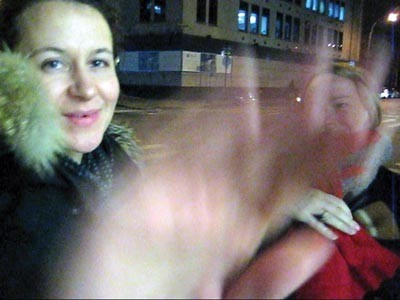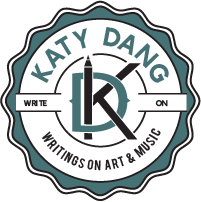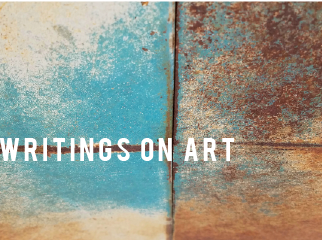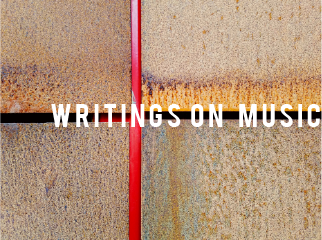James Kalm Report
“Kalm Down-Low: The Kalm Report shows it like it is”
By Katy Dang
IAQ | June 2009
https://www.boiseweekly.com/boise/kalm-down-low/Content?oid=1062224


“This is James Kalm, the guy on the bike, welcoming back our worldwide audience to another half-assed production.”
So begins each edition of the Kalm Report, a video blog available on the Internet that takes viewers straight into the heart of the New York art scene from the street level. With footage that offers tours of art shows, interviews with artists and images of the art alone, the Kalm Report places the viewer at the center of the action. In installments of 10 minutes or less, viewers are given insight into the hallowed halls of the art world, from artists busy hanging their shows to milling about with the beautiful people and hipperati on opening nights. It can be anywhere: at MOMA for a shiny rooftop chat with Jeff Koons; in the Williamsburg studio of Joyce Pensato; being annoying on Dutch TV with Marlene Dumas; looking at Peter Doig’s new paintings at Gavin Brown’s Enterprise; touring the Armory Show 2009.
The Kalm Report is the brainchild of James Kalm, the alter ego of artist Loren Munk. Munk brings viewers into the midst of the action via videos posted on YouTube or his own Web page, lorenmunk.com. But Munk is no high-falutin’ critic, nor is he a self-absorbed Web videographer. His work on the Kalm Report falls somewhere between the lines of art critic, performance art and man on the street—albeit a very knowledgeable man on the street.
Munk was born in Salt Lake City, Utah, and moved to Pocatello when he was 10 years old. He attended Idaho State University in the 1970s with a focus on art. His work received honorable mentions in the Idaho Annual at the Boise Art Museum (now the Triennial). He left Idaho in 1978 for the big time in the Big Apple. Although he has been living in Brooklyn for nearly 30 years, he still doesn’t consider himself a true New Yorker. “My brothers still live in Idaho, and it’s been very important to me and my family to maintain a connection with the West, Idaho in particular,” he says. “If there is something that I’ve brought from my Idaho past that has influenced the work, I’d say it’s a belief in self-reliance and the do-it-yourself attitude.”
James Kalm was a pseudonym created to write brief reviews for NY Arts Magazine in the mid-’90s. “Because of the total lack of critical support that I’d received as a young painter, I pledged that I would try to keep an eye on the margins, look at young and under-appreciated artists, the unfashionable, the female, the nutcases or the forgotten,” says Munk. “I would attack the barricades that the established tastemakers and power brokers had surrounded themselves with.”
Munk began to report as Kalm in 2006, in part as a response to an open letter “Call to Critics” by Irving Sandler in the December 2006 issue of The Brooklyn Rail. Sandler discussed the dismal state of art criticism, contending that the art market had overwhelmed the “disinterested” critical voice with financial interests and that criticism had become too over-academized, insular and specialized. Munk decided to act. “Art viewing shouldn’t be intimidating,” he says. “It should be cool and fun. Each viewer should be empowered to use their own intellectual tools to analyze, interpret and judge art. We should encourage different voices and different narratives.” With the help of a small digital camera and transported exclusively by an old Raleigh mountain bike, the Kalm Report was born.
Munk vehemently denies being a critic; instead, like Susan Sontag in her “Notes on Camp,” he admits to being an “enthusiast and a partisan.” He has written several hundred published articles and reviews, but a critic he is not. “First and foremost, I’m an artist,” says Munk. “My allegiance is with other artists and our community, so that’s one conflict of interest that precludes my pure objectivity.” In a mini-manifesto, he states, “Though the Kalm Reports have elements of art criticism, reportage, and documentation, they also constitute an act of performance art and should henceforth and to perpetuity be considered autonomous works of art in their own right.”
The Kalm Report is all part of a larger investigation into an overarching project of Munk’s that is based on his theory of the “Physics of Aesthetics.” Munk contends that artistic objects and ideas are basically natural, but the individual’s perceptions of them— what is known as “taste”—is created through a combination of various forces: history, criticism, social pressure, class, economics, fashion, etc. By identifying those forces at work, it is possible to locate where outside manipulation may occur, beyond the awareness of the viewer. In identifying these manipulations, Munk hopes to raise the conceptual horizon of the art viewer. “Rather than distinguishing between being a painter, historian, documentarian, vlogger or writer/critic, I consider it all part of the same art project: to understand the mystery of art by studying the history of art,” he says.
It is the unplanned nature of the Kalm Report that makes it so compelling. “One of my intentions is to allow people to see the works in more “real” surroundings,” says Munk. “I’m doing everything in a half-assed way. I show up with a Canon Elf in my pocket, no script, no lights, no plan, no tripod. I have to use whatever knowledge, experience and expertise I have to try and create situations and record things that other people might find intriguing.”
Munk’s intention remains the same after posting over 250 reports: to show viewers a more realistic, unscripted, non-commercial, behind-the-scenes view of the New York art world.
“It’s all the stuff the establishment doesn’t want you to see,” says Munk, “and then some.”



